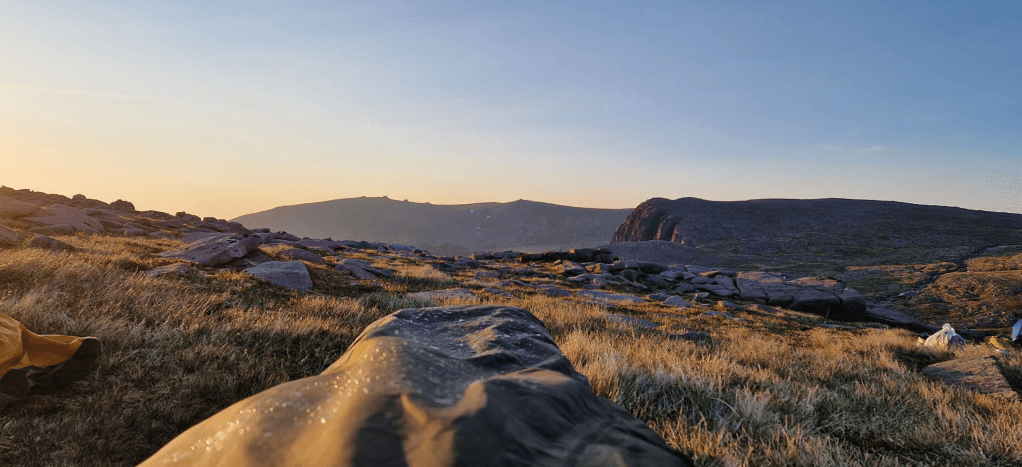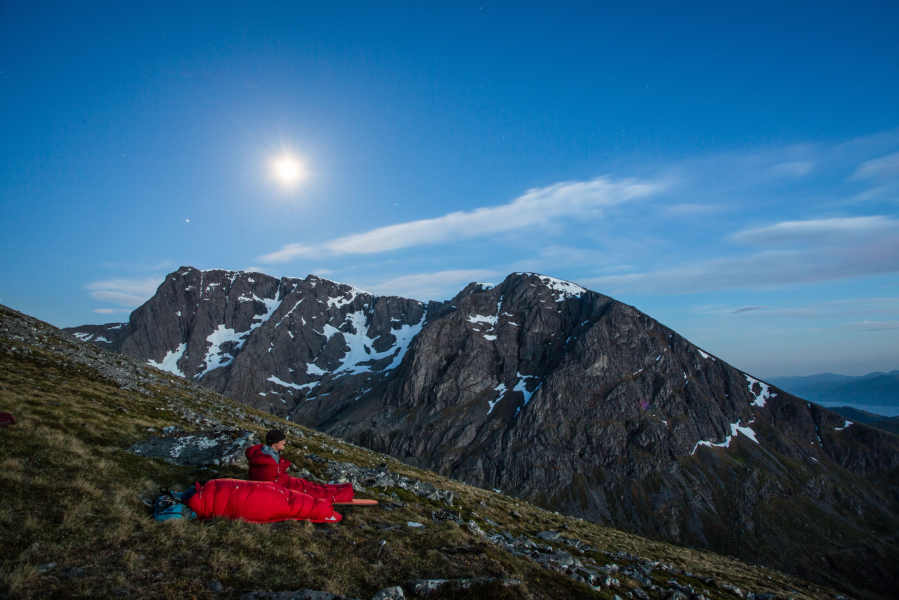Ian Kirk, Freelance Instructor at Glennmore Lodge, shares his eight top tips so your bivvying experience is memorable for all the right reasons.
BIVVYING – short for bivouacking – simply means sleeping outside without a tent. This ‘no-frills’ approach can be a very rewarding experience if you accept some comfort compromises. Travelling light to sleep out under an open sky from sunset to sunrise can leave you feeling connected to the elements in a way that tent camping simply cannot.
Main image: Bivvying under the mighty Ben Nevis | Credit: Dougie Cunningham
1. TAKE THE WEATHER WITH YOU
Weather has the biggest impact on bivvying – avoiding wet weather is best. Compare a couple of different local forecasts, taking note of wind speeds, UV index and chance of precipitation. To deepen your understanding mountain weather in the summer months, read Fi Chappell’s advice on page 50.
2. GROUND CONTROL
Your comfort will be enhanced with a good sleeping mat as your base against the ground. Mats come as either closed grass or moss on which to bivvy. It’s like nature’s mattress! Look out for drystone walls or old shelters by which to bivvy should the wind pick up. You’ll need a warm sleeping bag to crawl into, too. If you only have a lightweight summer sleeping bag, take warm layers of clothing that will make all the difference to your overnight comfort when the temperature drops.
3. TO TARP OR NOT TO TARP?
Where you’re intending to bivvy may inform what type of cover you’ll bring to protect your sleeping bag from morning dew and dampness. It’s good, however, to accept you won’t have the same level of protection as you would in a tent and, between condensation and dew, you are likely to get at least a little bit wet!
Bivvy bags are made from a range of materials, most of which are waterproof and breathable and provide an outer shell to protect you from the wind and damp air that may saturate your sleeping bag. Some bivvy bags come with open ends. Others have zipped heads that can fully enclose you, perhaps with the addition of a small hooped pole to hold it off of your face.
A tarp is a lightweight sheet similar to the outer sheet of a tent. Most require some form of pole to hold them up or are tied to other objects, such as trees or boulders to protect you from the elements. They are better suited to low-level camps.

The view from a bag on Feith Buidhe. Credit: Glenmore Lodge
4. STAY HYDRATED
Water is essential to both hydration and cooking! Where you are going will inform the level of care you have to take when sourcing water. A high mountainside burn in the Cairngorms is in complete contrast to a lower elevation hillside where there may be animals roaming.
Drinking straight from the burn/stream and away from habitation or a high volume of animals. Boiling can help, but it takes a while (plus cooling time) and only provides a little water.
the water and kill bacteria and other microorganisms that can cause stomach upsets. The downsides are that they must be left in water for some time before drinking, and they can leave a taste.
They remove sediment and can give volumes of water straight away. But they are bulky and require some effort to pump water through.
5. FOOD FOR THOUGHT
Everyone’s caloric requirements are different. If you are planning a longer trip or high bivvy after a mountain ascent, you should pack foods you can heat up with high caloric value. It’ll keep you fuelled and give you a comforting warm boost.
‘Wet’ and dehydrated foods both come in sealed packets and typically have a long shelf life. Wet foods can be eaten hot or cold; simply place the packet in boiling water on your stove to heat up. Dehydrated meals are comparatively lighter but need rehydrating with boiling water.
Or, take your pots and pans and make a meal from scratch, should your desired pack weight allow for an al fresco experience.
6. DINING AL FRESCO
There are innumerable cooking stoves on the market ranging from small pocket-sized gas burners to all-in-one cooking systems that pack away into a large cup.
If you opt for a small very lightweight gas burner-style stove, you’ll also have to carry pots in which to cook food or boil water, along with utensils and a cup or mug to drink from. This gives you the option of traditional style cooking, or using packet meals.
With an all-in-one cooking system, the components pack inside a large cup and are usually all held in a small bag along with the required gas. These are mostly used for heating ‘wet’ packet meals or for boiling water to put into dehydrated meals, although they do also have the option of allowing you to use pots and pans if weight or space is not an issue.
7. BIVVYING BITES
Whilst bivvying we will by lying on the ground and therefore more susceptible to midges and ticks.
Midges can swarm in their thousands and may be seen as a hazy cloud on still days between April and October. They can be present at even the highest of elevations. To avoid your bivvy becoming an itchy nightmare, pick a spot with a light breeze, which should keep them at bay. Midges do not like wind or strong sunlight. Take a midge net for your head and face.
Ticks reside in grass and heather where there are animals such as sheep or deer, waiting to bury their arrow-shaped heads into skin. Conduct regular tick checks, taking particular note of the warm, damp areas they favour such as backs of knees, elbows and under your watch. Carry and use a tick removal tool. Should you be bitten by a tick, keep an eye on the area should it become a circular or oval-shaped rash. This can potentially indicate Lyme disease, for which you must seek medical treatment to prevent further complications.
Wear long sleeves and trousers, ideally in lighter colours, in order to better notice the presence of a tick before it bites, and use repellent to ward off both midges and ticks.
8. A RIGHT TO ROAM?
Access to land in Britain for recreational purposes varies. Depending where you go, you may need to gain permission before bivvying. In Scotland, everyone has the right to responsible access to the outdoors – the Right to Roam – provided they follow the Scottish Outdoor Access Code.
It’s more complex in England and Wales, where there is only permission to access 8% of the land.
Glenmore Lodge is sportscotland’s National Outdoor Training Centre. Based near Aviemore in the Cairngorms National Park and founded in 1948, it exists to support individuals to access the outdoors safely and responsibly through providing skills training and inspiring adventure. Whether it’s trying a new way to enjoy the outdoors, aguided adventure, or professional experienced Instructors are ready to support everyone to develop their skills and achieve their aspirations in the outdoors.
Learn more at glenmorelodge.org.uk.






